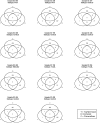Detection of novel fusion-transcripts by RNA-Seq in T-cell lymphoblastic lymphoma
- PMID: 30914738
- PMCID: PMC6435891
- DOI: 10.1038/s41598-019-41675-3
Detection of novel fusion-transcripts by RNA-Seq in T-cell lymphoblastic lymphoma
Abstract
Fusions transcripts have been proven to be strong drivers for neoplasia-associated mutations, although their incidence in T-cell lymphoblastic lymphoma needs to be determined yet. Using RNA-Seq we have selected 55 fusion transcripts identified by at least two of three detection methods in the same tumour. We confirmed the existence of 24 predicted novel fusions that had not been described in cancer or normal tissues yet, indicating the accuracy of the prediction. Of note, one of them involves the proto oncogene TAL1. Other confirmed fusions could explain the overexpression of driver genes such as COMMD3-BMI1, LMO1 or JAK3. Five fusions found exclusively in tumour samples could be considered pathogenic (NFYG-TAL1, RIC3-TCRBC2, SLC35A3-HIAT1, PICALM MLLT10 and MLLT10-PICALM). However, other fusions detected simultaneously in normal and tumour samples (JAK3-INSL3, KANSL1-ARL17A/B and TFG-ADGRG7) could be germ-line fusions genes involved in tumour-maintaining tasks. Notably, some fusions were confirmed in more tumour samples than predicted, indicating that the detection methods underestimated the real number of existing fusions. Our results highlight the potential of RNA-Seq to identify new cryptic fusions, which could be drivers or tumour-maintaining passenger genes. Such novel findings shed light on the searching for new T-LBL biomarkers in these haematological disorders.
Conflict of interest statement
The authors declare no competing interests.
Figures



References
Publication types
MeSH terms
Substances
LinkOut - more resources
Full Text Sources
Other Literature Sources

